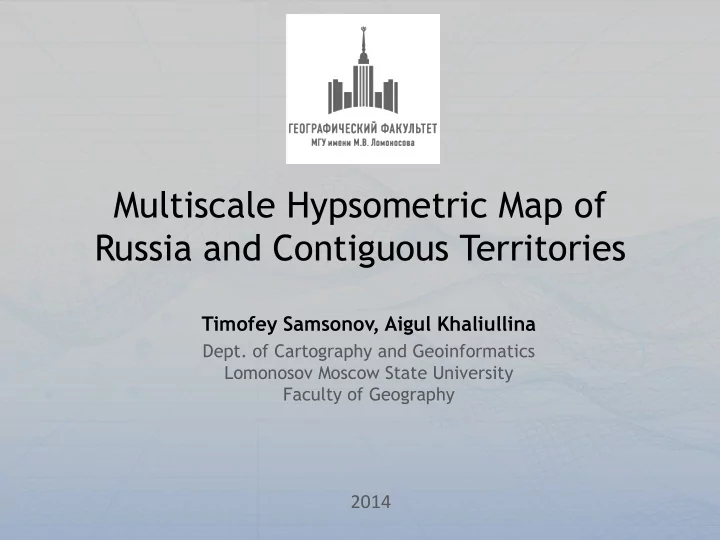

Multiscale Hypsometric Map of Russia and Contiguous Territories Timofey Samsonov, Aigul Khaliullina Dept. of Cartography and Geoinformatics Lomonosov Moscow State University Faculty of Geography 2014
Hypsometric mapping A.A.Tillo Hypsometric map of European Russia 1889 Y. Shokalsky Hypsometric map of European Russia 1912 г. K.A.Salischtschev “Map of Kolyma region” 1931 г. E. Imhof Swiss School Atlas (1962-1976 гг.)
Hypsometric Mapping • Middle and small scales • Vivid, exaggerated representation of major terrain features • Layered color tints • Often combined with hillshading
THE GOAL • Interactive web-based cartographic resource about relief of Russia and contiguous territories for higher education – Multiscale representation: from 1:200 000 to 1:50 000 000 – Macro-size relief forms (not large-scale) – Landform partonomic classification with detailed description of every region – Layered hypsometric tints for terrain representation at every scale
Cartographic Challenges Generation of high-quality DEMs for scales smaller than 1:1 000 000 Coherent hypsometric scales for the whole range of levels of detail Multi-color hypsometric scales for 1:200 000 and 1:500 000 levels of detail
Questions 1. What to represent? 2. How to represent? 3. From what data? 4. How to share?
PART 1 — WHAT TO REPRESENT? LANDFORM HIERARCHICAL CLASSIFICATION AND ZONING
Hierarchical structure of relief • Mapping scales and principles of cartographic relief presentation are closely related to hierarchical nature of topography Natural phenomena have relationships with structure of relief at different levels of their organization Tectonic structures Soils Vegetation … Multiscale hypsometric mapping is an effective solution
From hierarchy to classification • Geomorphological zoning by Voskresensky et al. (1980) �
Geomorphological zoning • Unique sliding classification by Voskresensky et al. (1980) • Several factors are used at every level
From paper towards digital representation All pictures were scanned and the most suitable projection • selected for every region • Georeferenced integrated were into seamless mosaic Scanning Georeferencing Building Seamlines Mosaicking
Digital mapping Digitizing Attributes 16 countries 52 provinces Mapping attributed 56 subprovinces digitized 200 oblasts 136 suboblasts 940 regions
PART 2 — HOW TO REPRESENT? HYPSOMETRIC SCALES
Testing color scales Darkening scales Lightening scales
The first experience: 1: 2 500 000 and smaller Color tree: the changes are logical and sequential between scales
Layered hypsometric tints : 1:500 000 and larger Mapping for print Mapping for Web/Desktop 1. Large Scale = Small Extent 1. Large Scale ≠ Small Extent 2. Limited height variation 2. Unlimited height variation 3. Restrained number of steps 3. Overflowing number of steps 4. Development of color scale is 4. Development of color scale conventionally simple is conventionally complex Extent Extent Hypsometric Layers should be distinguishable and comparable with legend
Why not gradient shading? ✔ Layered ✗ Gradient 1. Better representation of planar shape 2. Better representation of elevation distribution 3. All-sufficient without hillshading 4. Better for scientific purposes and higher education
Extension to 1:200 000 — Attempt 1
Extension to 1:200 000 — Attempt 2
1:200 000
1:500 000
1:1 000 000
1:2 500 000
PART 3 — DATA SOURCES TERRAIN GENERALIZATION
Data Sources Data source Target Scale SRTM90 1:100 000 GMTED2010 7.5'' 1:200 000 GMTED2010 15'' 1:500 000 GMTED2010 30'' 1:1 000 000 ETOPO1 / CUSTOM 1:2 500 000 ETOPO1 / CUSTOM 1:5 000 000 ETOPO2 / CUSTOM 1:10 000 000 ETOPO2 / CUSTOM 1:20 000 000 ETOPO5 / CUSTOM 1:50 000 000 CUSTOM — generated by customized algorithm for some territories
DEM Generalization The criteria for stream generalization are the length and flow accumulation level at the source
DEM Generalization 0. Original DEM
DEM Generalization 1. Primary streams
DEM Generalization 2. Primary watersheds
DEM Generalization 3. Secondary streams
DEM Generalization 4. Secondary watersheds
DEM Generalization 4. Secondary watersheds (without streams)
DEM Generalization 5. Triangulate layers
DEM Generalization 5. Triangulate layers
DEM Generalization 6. Rasterize TIN
DEM Generalization 7. Widen valleys and watersheds
DEM Generalization 8. Smooth
DEM Generalization 1. Primary streams
Widening • Adapted from Leonowicz, Jenny & H ü rni (2009) Automatic generation of hypsometric layers for small-scale maps. Computers & Geosciences, 35, p. 2074 – 2083. • Not used as generalization method but only for post-processing • Original method may produce semi- generalized landforms as small valleys are not removed directly but only as a result of filtering • Smooth weighting using the Euclidian distance is used instead of buffering MIN and MAX filters instead of • quartiles • Ridges are widened as well to enhance the readability
Widening 0. Original DEM
Widening 1. Valley DEM — MIN filter
Widening 2. Ridge DEM — MAX filter
Widening 1. Streams
Widening 2. Euclidian distance
Widening 3. Valley weights Valleys D D — zone of infection
Widening 4. Ridge weights Valleys Ridges D D — zone of infection
Widening 5. Source DEM weights Original
Widening 6. Weighted sum Z = Z 0 W 0 + Z val W val + Z ridge W ridge W 0 +W val +W ridge = 1 = x x x + +
Widening — profile view
Widening Original
Widening D = 1000 m
Widening D = 3000 m
DEM Generalization Toolbox for ArcGIS Python scripts • Generalize DEM — the whole workflow • Flow Accumulation to streams — extraction of streams • Widen — widening of valleys and ridges
1:2 500 000: Generalized DEM vs ETOPO1 Generalized GMTED 30” ETOPO1
PART 4 — HOW TO SHARE? MAP AND SERVICE
Layer Structure Active Scale Group Thematic Group Inactive scale groups
Terrain statistics • Heights and slope angles • Regular 6-degrees grid Slope angles 1. Dice DEM and project into UTM projection 2. Calculate slope angles 3. Mosaic slope angles • GMTED2010 7.5” (250 m) is used • Results can be improved using ASTER GDEM or WorldDEM
Information cards 5642
ArcGIS Online Map Service
ArcGIS Online Map Service Profiles
ArcGIS Online Map Service Descriptions
Perspectives 1. High-quality DEMs for small-scale hypsometric tinting covering whole world 2. New “multi - scale” color scales 3. Zone descriptions in separate panel 4. Elementary hydrologic analysis in web service 5. Photos attached 6. References to Wikipedia Thank you for attention! tsamsonov@geogr.msu.ru
Recommend
More recommend